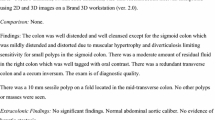Abstract
The purpose of this paper was to investigate the effect of radiologist experience and increasing exposure to CT colonography on reader performance. Three radiologists of differing general experience (consultant, research fellow, trainee) independently analysed 100 CT colonographic datasets. Readers had no prior experience of CT colonography and received feedback and training after the first 50 cases from an independent experienced radiologist. Diagnostic performance and reporting times were compared for the first and second 50 datasets and compared with the results of a radiologist experienced in CT colonography. Before training only the consultant reader achieved statistical equivalence with the reference standard for detection of larger polyps. After training, detection rates ranged between 25 and 58% for larger polyps. Only the trainee significantly improved after training (P=0.007), with performance of other readers unchanged or even worse. Reporting times following training were reduced significantly for the consultant and fellow (P<0.001 and P=0.03, respectively), but increased for the trainee (P<0.001). In comparison to the consultant reader, the odds of detection of larger polyps was 0.36 (CI 0.16, 0.82) for the fellow and 0.36 (CI 0.14, 0.91) for the trainee. There is considerable variation in the ability to report CT colonography. Prior experience in gastrointestinal radiology is a distinct advantage. Competence cannot be assumed even after directed training via a database of 50 cases.




Similar content being viewed by others
References
Yee J, Akerkar GA, Hung RK, Steinauer-Gebauer AM, Wall SD, McQuaid KR (2001) Colorectal neoplasia: performance characteristics of CT colonography for detection in 300 patients. Radiology 219:685–692
Fenlon HM, Nunes DP, Schroy PC III, Barish MA, Clarke PD, Ferrucci JT (1999) A comparison of virtual and conventional colonoscopy for the detection of colorectal polyps. N Engl J Med 341:1496–1503
Macari M, Bini EJ, Xue X, Milano A, Katz SS, Resnick D, Chandarana H, Krinsky G, Klingenbeck K, Marshall CH, Megibow AJ (2002) Colorectal neoplasms: prospective comparison of thin-section low-dose multi-detector row CT colonography and conventional colonoscopy for detection. Radiology 224:383–392
Dachman AH (2002) Diagnostic performance of virtual colonoscopy. Abdom Imaging 27:260–267
Rex DK, Vining D, Kopecky KK (1999) An initial experience with screening for colon polyps using spiral CT with and without CT colonography (virtual colonoscopy). Gastrointest Endosc 50:309–313
Yee J, Kumar NN, Hung RK, Akerkar GA, Kumar PR, Wall SD (2003) Comparison of supine and prone scanning separately and in combination at CT colonography. Radiology 226:653–661
Nodine CF, Kundel HL, Mello-Thoms C, Weinstein SP, Orel SG, Sullivan DC, Conant EF (1999) How experience and training influence mammography expertise. Acad Radiol 6:575–585
Halligan S, Marshall MM, Taylor SA, Bartram CI, Atkin W (2003) Observer variation in detection of colorectal neoplasia on double-contrast barium enema: implications for colorectal cancer screening and training. Clin Radiol 58:948–954
Gluecker T, Meuwly JY, Pescatore P, Schnyder P, Delarive J, Jornod P, Meuli R, Dorta G (2002) Effect of investigator experience in CT colonography. Eur Radiol 12:1405–1409
Pescatore P, Glucker T, Delarive J, Meuli R, Pantoflickova D, Duvoisin B, Schnuder P, Blum AL, Dorta G (2000) Diagnostic accuracy and interobserver agreement of CT colonography (virtual colonoscopy). Gut 47:126–130
McFarland EG, Pilgram TK, Brink JA, McDermott RA, Santillan CV, Brady PW, Heiken JP, Balfe DM, Weinstock LB, Thyssen EP, Littenberg (2002) CT colonography: multiobserver diagnostic performance. Radiology 225:380–390
Taylor SA, Halligan S, Saunders BP, Morley S, Riesewyk C, Atkin W, Bartram CI (2003) Use of multidetector-row CT colonography for detection of colorectal neoplasia in patients referred via the Department of Health “2-Week-wait” initiative. Clin Radiol 58:855–861
Dachman AH, Kuniyoshi JK, Boyle CM, Samara Y, Hoffmann KR, Rubin DT, Hanan I (1998) CT colonography with three-dimensional problem solving for detection of colonic polyps. Am J Roentgenol 171:989–995
Taylor SA, Halligan S, Goh V, Bassett P, Atkin W, Bartram CI (2003) Optimising colonic distension for multidetector-row CT colonography: effect of hyoscine butylbromide and rectal balloon catheter. Radiology 219:99–108
Kan L, Olivotto IA, Warren Burhenne LJ, Sickles EA, Coldman AJ (2000) Standardized abnormal interpretation and cancer detection ratios to assess reading volume and reader performance in a breast screening program. Radiology 215:563–567
Halligan S (2002) Subspecialist radiology. Clin Radiol 57:982–983
Denton ER, Field S (1997) Just how valuable is double reporting in screening mammography? Clin Radiol 52:466–468
Sickles EA, Wolverton DE, Dee KE (2002) Performance parameters for screening and diagnostic mammography: specialist and general radiologists. Radiology 224:861–869
Tudor GR, Finlay DB (2001) Error review: can this improve reporting performance? Clin Radiol 56:751–754
Fidler JL, Johnson CD, MacCarty RL, Welch TJ, Hara AK, Harmsen WS (2002) Detection of flat lesions in the colon with CT colonography. Abdom Imaging 27:292–300
Acknowledgements
This research was supported by a research fellowship from the Royal College of Radiologists, the Wexham Gastrointestinal Trust, and by General Electric Medical Systems, Slough, UK.
Author information
Authors and Affiliations
Corresponding author
Rights and permissions
About this article
Cite this article
Taylor, S.A., Halligan, S., Burling, D. et al. CT colonography: effect of experience and training on reader performance. Eur Radiol 14, 1025–1033 (2004). https://doi.org/10.1007/s00330-004-2262-z
Received:
Revised:
Accepted:
Published:
Issue Date:
DOI: https://doi.org/10.1007/s00330-004-2262-z




